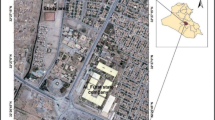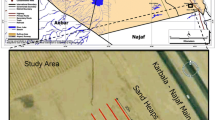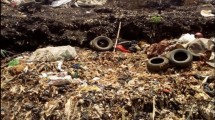Abstract
2D imaging technique was applied in (8) transects near a pit of contaminated water near contaminated well southeast of Karbala city, Iraq. Each transect was 30 m long with 1 m electrode spacing. Data acquisition was fulfilled by using Wenner electrode array. The resistivity of water-contaminated zone is found less than 3Ω.m and the top dry zone recorded relatively high resistivity (more than 170Ω.m). It is found that the greatest amount of seepage was found moving towards northeast direction coincided with groundwater movement direction, whereas there was no movement towards northwest and southeast directions and restricted on the closest areas to the pit location. The outcomes suggested that the 2D imaging technique is a successful and powerful tool in separating contaminated zone from clear one and in detecting underground seepage depth and moving direction.






Similar content being viewed by others

References
Aljibury HK (2002) Hydrogeological and hydrochemical study of Karbala quadrangle, scale 1:250000, GEOSURV, Report No. 2825, 60p
Allen JP, Atekwana EA, Atekwana EA, Duris JW, Werkema DD, Rossbach S (2007) The microbial community structure in petroleum-contaminated sediments corresponds to geophysical signatures. Appl Environ Microbiol 73(9):2860–2870
AL-Menshed FH, Thabit JM (2016) The use of an azimuthal resistivity survey to detect the flow direction of hydrocarbons in the unsaturated zone at Karbala Governorate, Iraq. Environ Earth Sci 75(1328):1–11
Andres KG, Canace R (1984) Use of the electrical resistivity technique to delineate a hydrocarbon spill in the coastal plain deposits of New Jersey. In Proceedings of the NWWA/API Conference on petroleum hydrocarbons and organic chemicals in ground water-prevention, detection and restoration, Houston, pp 188–197
Atekwana E, Cassidy DP, Magnuson C, Endres AL, Werkema Jr DD, Sauck WA (2001) Changes in geoelectrical properties accompanying microbial degradation of LNAPL. In Proceedings of the Symposium on the Application of Geophysics to Engineering and Environmental Problems, pp 1–10
Atekwana EA, Atekwana EA, Rowe RS, Werkema DD, Legall FD (2004) The relationship of total dissolved solids measurements to bulk electrical conductivity in an aquifer contaminated with hydrocarbon. J Appl Geophys 56:281–294
Barker R, Rao TV, Thangarajan M (2001) Delineation of contaminant zone through electrical imaging technique. Curr Sci 81(3):277–283
Barwary AM, Slewa NA (1995) Series of geological maps of Iraq scale 1:250000 Karbala Quadrangle NI – 38 – 14. GEOSURV Library Baghdad, Iraq, Rep. No. 2318, 25 p
Borden RC (1994) Hand book of bioremediation. CRC Press, Boca Raton, pp 177–199
deGroot-Hedlin C, Constable S (1990) Occam’s inversion to generate smooth two-dimensional models from magnetotelluric data. Geophysics 55:1613–1624
Dahlin T, Loke MH (1998) Resolution of 2D wenner resistivity imaging as assessed by numerical modeling. J Appl Geophys 38:237–249
Dahlin T, Zhou B (2001) A numerical comparison of 2D resistivity imaging with eight electrode arrays, Procs. 7th Meeting Environmental and Engineering Geophysics,Birmingham,England,2–3 September 2001,ELEMO1,2p
Dahlin T, Zhou B (2004) A numerical comparison of 2D resistivity imaging with 10 electrode arrays. Geophys Prospect 52:379–398
Delgado-Rodríguez O, Shevnin V, Ochoa-Valdés J, Ryjov A (2006) Geoelectrical characterization of a site with hydrocarbon contamination caused by pipeline leakage. Geofísica Int 45(1):63–72
Dey A, Morrison HF (1979) Resistivity modeling for arbitrarily shaped three-dimensional shaped structures. Geophysics 44:753–780
Gajdos V, Kral V (1995) Influence of hydrocarbon pollution to soil conductivity. In: Bell, R.S. _Ed.., Proceedings of the Symposium on the Application of Geophysics to Engineering and Environmental Prob- lems _SAGEEP 1995., Orlando, FL, 785–789.Geotomo software, 2005: RES3DINV ver. 2.15. 3D Resistivity and IP inversion program. WWW.geoelectrical.com
Griffiths DH, Barker RD (1993) Two-dimensional resistivity imaging and modelling in areas of complex geology. J Appl Geophys 29(3–4):211–226
Hassan KM, Al-Khateeb AAG, Khlaif HO, Kadhum MA, Saeed FS (2002) Detailed geological survey for mineral exploration in Karbala–Najaf area. Part 1, Geology. GEOSURV, Int. rep. No. 2874
Loke MH (2012) Tutorial: 2-D and 3-D electrical imaging surveys. http://www.geotomosoft.com/downloads.php. 110 pp
Loke MH, Barker RD (1995) Least-squares deconvolution of apparent resistivity pseudosections. Geophysics 60(6):1682–1690
Mazáč, O., Benes, L., Landa, I., & Maskova, A. (1990). Determination of the extent of oil contamination in groundwater by geoelectrical methods. Geotech Environ Geophys 2:107–112
Sadowski RM (1988) Clay-organic interactions. MSc. Thesis, Dept. of Geochemistry, Colo. School of Mines, p 209
Sasaki Y (1992) Resolution of resistivity tomography inferred from numerical simulation. Geophys Prospect 40:453–464
Sauck WA 1998 A conceptual model for the geoelectrical response of LNAPL plumes in granular sediments. Proceeding of the symposium on the application of geophysics to engineering and environmental problems, 11, 805–817
Sauck WA (2000) A model for the resistivity structure of LNAPL plumes and their environs in sandy sediments. J App Geophys 44:151–165
Shevnin V, Delgado-Rodríguez O, Mousatov A, Nakamura-Labastida E, Mejia-Aguilar A (2003) Oil pollution detection using resistivity sounding. Geofisica Int 42(4):613–622
Shevnin V, Delgado-Rodríguez O, Fernández-Linares L, Martínez HZ, Mousatov A, Ryjov A (2005) Geoelectrical characterization of an oil-contaminated site in Tabasco, Mexico. Geofísica Int 44(3):251–263
Waxman MH, Thomas EC (1974) Electrical conductivities in shaly sands. I. The relation between hydrocarbon saturation and resistivity index. II. The temperature coefficient of electrical conductivity. J Petrol Tech Trans AIME 257:213–225
Acknowledgements
The authors would like to thank the general director of General Commission for Groundwater (Mr. Dhafir Abdullah) and investigation department staff for providing requirements for achieving the field work and helping me with necessary information about the studied area and the contaminated well.
Author information
Authors and Affiliations
Corresponding author
Additional information
Responsible editor: Philippe Garrigues
Rights and permissions
About this article
Cite this article
AL-Menshed, F.H., Thabit, J.M. Evaluation of 2D resistivity imaging technique for delineating subsurface seepage of hydrocarbon-contaminated water southeast of Karbala city, Iraq. Environ Sci Pollut Res 24, 6523–6531 (2017). https://doi.org/10.1007/s11356-016-8310-9
Received:
Accepted:
Published:
Issue Date:
DOI: https://doi.org/10.1007/s11356-016-8310-9



